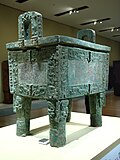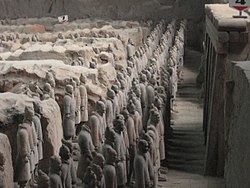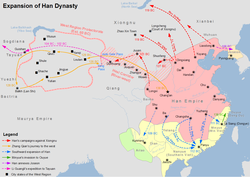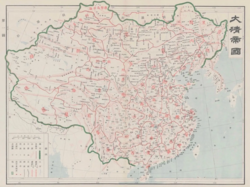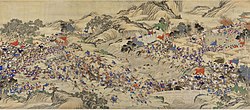History of China
| History of China | |||||||
|---|---|---|---|---|---|---|---|
| ANCIENT | |||||||
| Neolithic c. 8500 – c. 2070 BC | |||||||
| Xia dynasty c. 2070 – c. 1600 BC | |||||||
| Shang dynasty c. 1600 – c. 1046 BC | |||||||
| Zhou dynasty c. 1046 – 256 BC | |||||||
| Western Zhou | |||||||
| Eastern Zhou | |||||||
| Spring and Autumn | |||||||
| Warring States | |||||||
| IMPERIAL | |||||||
| Qin dynasty 221–206 BC | |||||||
| Han dynasty 206 BC – 220 AD | |||||||
| Western Han | |||||||
| Xin dynasty | |||||||
| Eastern Han | |||||||
| Three Kingdoms 220–280 | |||||||
| Wei, Shu and Wu | |||||||
| Jin dynasty 265–420 | |||||||
| Western Jin | |||||||
| Eastern Jin | Sixteen Kingdoms | ||||||
| Southern and Northern Dynasties 420–589 | |||||||
| Sui dynasty 581–618 | |||||||
| Tang dynasty 618–907 | |||||||
| (Wu Zhou interregnum 690–705) | |||||||
| Five Dynasties and Ten Kingdoms 907–960 |
Liao dynasty 907–1125 | ||||||
| Song dynasty 960–1279 |
|||||||
| Northern Song | W. Xia | ||||||
| Southern Song | Jin | ||||||
| Yuan dynasty 1271–1368 | |||||||
| Ming dynasty 1368–1644 | |||||||
| Qing dynasty 1644–1911 | |||||||
| MODERN | |||||||
| Republic of China 1912–1949 | |||||||
| People's Republic of China 1949–present |
Republic of China on Taiwan 1949–present | ||||||
The History of China covers thousands of years. The earliest records are from about 1250 BC, but a few things are known about earlier times. Chinese history covers many periods and dynasties. See Ancient China for the earliest times.
Imperial China
Qin dynasty
The Qin Dynasty was very important in the history of China. They followed the philosophy of Legalism. Their capital was at Xianyang. Under the emperor of this dynasty, Qin Shi Huang, China became a powerful country. Many new things were done for the first time. A tight legal system was followed. Written language was developed. The common currency was used. The building of the Great Wall of China was started.
Han dynasty
The Han dynasty was founded by Liu Bang after the Qin dynasty ended. During the Han dynasty, the territory of China expanded, and many advancements in science and technology took place. It was considered a golden age in Chinese history.
The Three Kingdoms
The Three Kingdoms period (traditional Chinese: 三國; simplified Chinese: 三国; pinyin: Sānguó) is a period of history where China was divided into the states of Cao Wei, Shu Han, and Eastern Wu. The Eastern Han dynasty lost all power. Eventually, the Han dynasty emperor abdicated.
Jin dynasty
The Jin dynasty (1115–1234) is also known as the Jurchen dynasty and as the Great Jin. It was one of the last dynasties before the Mongol invasion (and eventual conquest) of China.
The dynasty was founded by the Wanyan (完顏 Wányán) clan of the Jurchens. These were the ancestors of the Manchu, who established the Qing dynasty some 500 years later. The Jin Dynasty was founded in northern Manchuria, The founder was Wanyan Aguda (完顏阿骨打).
The name of this dynasty is sometimes written as Jinn to differentiate it from an earlier Jin dynasty (265-420) of China whose name is spelled identically in the Roman alphabet. The History of Jin recorded that Tangkuo Dingge (唐括定哥), Consort Gui (貴妃) was a Jurchen woman. She was first married to the Jurchen Jin royal Wanyan Wudai (完顏烏帶. She had an affair with her Han Chinese slave, Yan Qi'er (閻乞兒), and with Wanyan Liang (Prince Hailing). When Wanyan Liang became emperor of the Jin dynasty he forced Dingge to have her husband Wanyan Wudai killed by her other slaves, Ge Wen (葛溫) and Ge Lu (葛魯) and he promised that she would be named empress. Wanyan Liang broke his promise after he got bored of her when she entered the harem. Dingge then smuggled Yan Qi'er into the palace through a trunk after first smuggling a trunk full of her clothes as a dummy and then reprimanded him for looking at her clothes so he wouldn't look when Yan Qi'er was smuggled in next. Dingge and Yan Qi'er had sex until a Jurchen maid, Guige (貴哥) told them to the emperor and Dingge was strangled and Yan Qi'er was beheaded.
Sui dynasty
The Sui Dynasty (隋朝 Suí cháo; 581-618) was founded by Emperor Wen, or Yang Jian. Its capital was Chang'an (present-day Xi'an). The dynasty is important because it reunited Southern and Northern China and the Grand Canal was built then.
Tang dynasty
The Tang Dynasty was founded by the Li (李) family, who came to power during the fall of the Sui Empire. The dynasty was interrupted for a short time by the Second Zhou Dynasty (16 October 690–3 March 705) when Empress Wu Zetian managed to claim the throne, becoming the first and only Chinese Empress.
The capital of the Tang, Chang'an (today Xi'an), was the biggest city in the world at the time. Many historians see the Tang dynasty as a high point in Chinese civilization and as a golden age of cosmopolitan culture.
The concept of inalienable private property has grown in China since the Tang dynasty.[1] Chinese land deeds are preserved from medieval times[2] and there were even land deeds for the afterlife in tombs in the Six dynasties.[3]
Song dynasty
The Song dynasty maintained the image and memory of the "universal empire" of the Han dynasty and Tang dynasty periods despite contracting in size.[4]
One of the descendants of the Yan clan during the Song dynasty was Yan Zhengqing. When Eastern Jin was set up by Han Chinese nobles fleeing south, Yan Han was among the nobles and he was the ancestor of the Yan clan, who were related by blood to the Langye nobles who they married including the Wang clan of Langye, the Yin Clan of Chen commandery and Shen clan of Wuxing. Yan Han was the 13th generation ancestor of Yan Zhenqing.[5]
Yuan dynasty
The Yuan Dynasty was first ruled by Genghis Khan, a Mongolian leader who took control of the Song Dynasty. He was considered a barbarian and not civilized. His grandson, Kublai Khan, was one of the most famous and liked rulers of the Yuan dynasty. He opened up China to many other cultures and improved life for the Chinese very much.
Ming dynasty
In 1368, a rebellion led by Zhu Yuanzhang broke out in southern China and eventually overthrew the Yuan Dynasty. Then, Zhu Yuanzhang founded the Ming Dynasty at Nanjing, its capital until Emperor Yongle changed the capital to Beijing.
In the 15th century, a man named Zheng He took the majority of the Ming navy to explore the Indian Ocean and brought wealth and power to the Ming Dynasty. The empire experienced a prosperous period until 1449 when the Battle of Tumu Fortress broke out. In the battle, the Mongol descendants of Yuan captured the emperor and surrounded the capital. After the war with the Mongols, the Ming started to decline. During this time, the empire had two wars with the Japanese (the first against the Japanese pirates took place in southeastern China; the second against the armies of Toyotomi Hideyoshi that invaded Korea), and one war with the Portuguese of Macao. These wars eventually weakened the declining empire. In 1616, rebellions broke out at Manchuria and Shanxi. Twenty-eight years later, the Manchus crossed the Great Wall, invaded the capital, and destroyed the Shanxi rebels.
Qing dynasty
Horses, cattle, farms, villages, servants, slaves, homes, and wives were given by Nurhaci to Jurchens who defected like Guwalca, Hurha, and Warka as well as Han Chinese defectors and Mongol defectors to Later Jin.[6]
Jurchen chiefs were given Korean women as wives by Joseon to control them.[7]
Scholars commissioned by Qianlong when editing historical texts and making commentaries on them often made up fanciful and completely fictional etymologies. One of the works they did was analyzing Jurchen clans mentioned in the History of Jin and trying to match their names to the Manchu clans that still exist.[8][9]
Some Han bannermen promoted to Manchu banners added giya to the end of their surname.[10][11][12] The ethnic identity of the Tong family of Liaodong during the late Ming and early Qing has been debated by historians.[13][14][15][16][17]
The Oirat Torghut Kalmyk Mongol leader Khatun Khan was jailed by Yaqub Beg as he was attacking the Oirats in Kurla and attacking Hui forces for Tuo Ming, Daud Khalifa in Ürümqi with the help of Han militia under Xu Xuegong.[18][19][20][21]
Modern era
The Republic of China
People's Republic of China
Mao Zedong was the leader of the People's Republic of China from 1949 until he died in 1976.
In the 21st century, China became the richest country in the world in terms of GDP.
Timeline
- 3 Sovereigns and 5 Emperors: 50,000 – 2000 BC
- Xia Dynasty: c. 2000 – c. 1600 BC
- Shang Dynasty (or Yin Dynasty): c. 1600 – 1046 BC
- Zhou Dynasty
- Western Zhou: 1046 – 771 BC
- Eastern Zhou
- Spring and Autumn period: 771 – 481 BC
- Warring States period: 481 – 221 BC
- Qin Dynasty: 221 – 206 BC
- Han Dynasty: 206 BC – 220 AD
- Western Han: 206 BC – 8 AD
- Xin Dynasty: 8 – 23 AD
- Three Kingdoms
- The Kingdom of Wei: 220 – 265 AD
- The Kingdom of Shu: 221 – 263 AD
- The Kingdom of Wu: 229 – 280 AD
- Jin Dynasty
- Western Jin: 265 – 316 AD
- Eastern Jin: 317 – 460 AD
- The Sixteen Kingdoms
- "Former Zhao" or "Han Zhao": 304 – 329 AD
- "Cheng Han" or "Former Shu": 306 – 347 AD
- Former Liang: 314 – 376 AD
- "Later Zhao" or "Shi Zhao": 319 – 351 AD
- Former Yan: 334 – 370 AD
- "Former Qin" or "Fu Qin": 351 – 394 AD
- Later Yan: 384 – 409 AD
- "Later Qin" or "Iau Qin": 384 – 417 AD
- Western Qin: 385 – 431 AD
- "Later Liang" or "Lu Liang": 389 – 403 AD
- Southern Liang: 397 – 414 AD
- Southern Yan: 398 – 410 AD
- Western Liang: 400 – 421 AD
- Northern Liang: 401 – 439 AD
- "Xia" or "Hu Xia": 407 – 431 AD
- "Northern Yan" or "Feng Yan": 409 – 436 AD
The countries below are not included in the sixteen kingdoms:
- Former Chouchi: 296 – 371 AD
- Later Chouchi: 385 – 443 AD
- Dai: 315 – 376 AD
- Ran Wei: 350 – 352 AD
- Western Yan: 384 – 394 AD
- Zhai Wei: 388 – 392 AD
- Western Shu: 405 – 413 AD
- Yuwenbu: 302 – 344 AD
- Duanbu: 310 – 357 AD
- Tuguhun: 313 – 633 AD
- Southern and Northern Dynasties
- Southern Dynasties
- Song: 420 – 479 AD
- Chi: 479 – 502 AD
- Liang: 502 – 557 AD
- Chen: 557 – 589 AD
- Northern Dynasties
- Northern Wei: 386 – 534 AD
- Eastern Wei: 534 – 550 AD
- Western Wei: 535 – 557 AD
- Northern Chi: 550 – 557 AD
- Northern Chou: 557 – 581 AD
- Southern Dynasties
- Sui Dynasty: 581 – 618 AD
- Tang Dynasty: 618 – 907 AD
- Tang Dynasty had been interrupted by Wu Chou: 690 – 705 AD
- Five Dynasties and Ten Kingdoms
- Five Dynasties
- Later Liang: 907 – 923 AD
- Later Tang: 923 – 936 AD
- Later Jin: 936 – 947 AD
- Later Han: 947 – 950 AD
- Later Chou: 951 – 960 AD
- Ten Kingdoms
- Wu Yue: 904 – 978 AD
- Min (changed its name to Yin at 943 AD): 909 – 945 AD
- Jinnan: 907 – 963 AD
- Chu: 897 – 951 AD
- Wu: 904 – 973 AD
- Southern Tang: 937 – 975 AD
- Southern Han: 917 – 971 AD
- Northern Han: 951 – 979 AD
- Former Shu: 907 – 925 AD
- Later Shu: 934 – 965 AD
- And other regimes
- Dingnan Jiedu: 881 – 982 AD
- Fongshang Jiedu (or Chi): 887 – 924 AD
- Lulong Jiedu (or Yan): 897 – 913 AD
- Chender Jiedu (or Zhao): 883 – 921 AD
- Yiwu Jiedu: 900(?) – 922 AD and 928 – 929 AD
- Wuping Jiedu (or Hunan Jiedu): 950 – 963 AD
- Chinyuan Jiedu: 946 – 978 AD
- Hexi Regime: ?
- Five Dynasties
- Song Dynasty
- Northern Song: 960 – 1127 AD
- Southern Song: 1127 – 1279 AD
- Liao Dynasty (or Khitan) - 907 – 1125 AD
- After the Gin Dynasty ends the Liao Dynasty, Yelü Dashi, an aristocrat of Liao, rebuilded the Liao Dynasty, we call it Western Liao, also known as Kara-Khitan Khanate: 1132 – 1218 AD
- Gin Dynasty: 1115 – 1234 AD
- Western Xia: 1038 – 1227 AD
- Yuan Dynasty (Actually the Mongolia): 1279 – 1368 AD
- Ming Dynasty: 1368 – 1644 AD
- Qing Dynasty: 1636 – 1912 AD
- The Republic of China: 1912 AD – now (It only ruled mainland China until 1949. It lost in the Chinese Civil War, so now it only rules Taiwan, Penghu, Kinmen, Mazhu, the Taiping Island and the Dongsha Island. The Republic of China after 1949 is actually Taiwan.)
- The People's Republic of China: 1949 AD – now
History Of China Media
Decorative plaque from the Erlitou culture
The 12th-century BC Houmuwu ding, the largest Bronze Age bronzeware found anywhere in the world
The massive Terracotta Army of Qin Shi Huang, a UNESCO World Heritage Site
A map of the Qing dynasty, c. 1820
A scene of the Taiping Rebellion
References
- ↑ Schurmann, H. F. (1956). "Traditional Property Concepts in China". The Far Eastern Quarterly. 15 (4): 507–16. doi:10.2307/2941921. ISSN 0363-6917. JSTOR 2941921. S2CID 163415578.
- ↑ "Chinese Land Records". ULS Digital Collections Digital Pitt.
- ↑ "Deed of land purchase for afterlife". Art Collection - The Metropolitan Museum of Art.
- ↑ Ge 葛, Zhaoguang 兆光 (2019). "Imagining a Universal Empire: a Study of the Illustrations of the Tributary States of the Myriad Regions Attributed to Li Gonglin". Journal of Chinese Humanities. NV, Leiden: Koninklijke Brill. 5 (2): 124–148. doi:10.1163/23521341-12340077. S2CID 225545785.
- ↑ McNair, Amy (1998). The Upright Brush: Yan Zhenqing's Calligraphy and Song Literati Politics. University of Hawaii Press. p. 94. ISBN 0824865146.
- ↑ Chinese Economic Journal and Bulletin, Volume 1, Issue 2. Chinese Government Bureau of Economic Information. 1927. p. 733.
As regards the Mongols, the Chinese, the Warka, Hurha and Guwalca who have of late come to swear allegiance, they have even been given wives, houses, slaves, servants, villages, fields, cattle, and horses .
- ↑ Huang, Pei (2011). Reorienting the Manchus– A Study of Sinicization, 1583–1795 (illustrated ed.). Cornell University Press. p. 156. ISBN 978-1933947921.
- ↑ Stary, Giovanni (1998). "The Manchu Identification of Jurchen Clan Names As Found in the "Manjusai da skin-i kitchen" (Manzhou yuanliu kao)". Saksaha: A Journal of Manchu Studies. 3. doi:10.3998/saksaha.13401746.0003.002.
- ↑ https://quod.lib.umich.edu/cgi/p/pod/dod-idx/manchu-identification-of-jurchen-clan-names-as-found.pdf?c=saksaha;idno=13401746.0003.002;format=pdf
- ↑ Crossley, Pamela Kyle (1999). A Translucent Mirror– History and Identity in Qing Imperial Ideology. ACLS Humanities E-Book (illustrated, reprint ed.). University of California Press. p. 81. ISBN 0520234243.
the Jurchen lineage whose name was written with the characters "Jiagu,"" In Möngke Temür's time the lineage name was what would ... and include Magiya (Majia), Gaogiya (Gao jia), Janggiya (Zhangjia), Joogiya (Zhaojia), Ligiya (Lijia), ...
- ↑ https://california.universitypressscholarship.com/view/10.1525/california/9780520215665.001.0001/upso-9780520215665-chapter-5 https://california.universitypressscholarship.com/view/10.1525/california/9780520215665.001.0001/upso-9780520215665-chapter-6?rskey=b3dAN3&result=10
- ↑ Huang, Pei (2011). Reorienting the Manchus– A Study of Sinicization, 1583–1795 (illustrated ed.). Cornell University Press. p. 224. ISBN 978-1933947921.
For a broad discussion of the Manchu naming and clan names, see ibid., 1–69. ... For the grandsons of Tuhai, see Majia shi zupu, comps. Ma Yanxi et al. (Peiping [?] ... For the sixteen characters, see the same Magiya clan genealogy, vol.
- ↑ Rowe, William T. (2010). China's Last Empire: The Great Qing. Vol. 6 of History of Imperial China (illustrated ed.). Harvard University Press. p. 11. ISBN 978-0674054554.
- ↑ https://www.iwp.edu/wp-content/uploads/2019/05/20150127_RoweChinaLastEmpireChapter1pp.1130.pdf
- ↑ Crossley, Pamela (1983). "The Tong in Two Worlds: Cultural Identities in Liaodong and Nurgan during the 13th-17th centuries". Ch'ing-shih Wen-t'i. 4 (9): 21–46.
- ↑ Crossley, Pamela Kyle (1987). "Manzhou Yuanliu Kao and the Formalization of the Manchu Heritage". The Journal of Asian Studies. 46 (4): 761–90. doi:10.2307/2057101. JSTOR 2057101. S2CID 162618002.
- ↑ Corradini, Piero (2002). "ON THE QIDAN AND JURČIN CAPITALS". Rivista Degli Studi Orientali. 76 (1/4): 169–213. JSTOR 41913109.
- ↑ Kim, Hodong (2004). illustrated (ed.). Holy War in China: The Muslim Rebellion and State in Chinese Central Asia, 1864-1877. Stanford University Press. p. 96. ISBN 0804767238.
Ya'qūb Beg spent the winter of 1870 in Urumchi where Xu Xuegong visited and presented him with gifts. Xu had visited him when Ya'qūb was staying in Turfan and provided him with some troops and provisions. His younger brother also ...
- ↑ Millward, James A. (2007). Eurasian Crossroads: A History of Xinjiang. Gale virtual reference library (illustrated ed.). Columbia University Press. p. 120. ISBN 978-0231139243.
In his first attack on the Tungan - held city, in 1870, Ya'qub Beg was joined by Xu Xuegong, a non - Muslim Han Chinese militia leader who had taken to the hills with 1,500 troops following the Tungan uprising .
- ↑ Dixon, Jeffrey S.; Sarkees, Meredith Reid (2015). A Guide to Intra-state Wars: An Examination of Civil, Regional, and Intercommunal Wars, 1816-2014. Correlates of war series A guide to intra-state wars (revised ed.). CQ Press. p. 457. ISBN 978-1452234199.
Dates: January 1870 to November 1870. Battle-related Deaths: Total ... Narrative: In early 1870, some 20,000 Tungans seized Kurla. ... Participants: Armed Forces of Kashgaria versus Urumchi Tungans and Xu Xuegong–led Guerrillas.
- ↑ Mende-Altaylı, Rana von (1999). Die Beziehungen des Osmanischen Reiches zu Kashghar und seinem Herrscher Ya'qub Beg, 1873-1877. Papers on inner Asia: Central Asia. Indiana University, Research Institute for Inner Asian Studies. p. 77.
Shusagun ( Shusagvan , i . e . der Milizführer Xu Xuegong ) , der zunächst Ya'qub Beg , der ihn nach Guan Shouxin ( 1996 , 69 ) unter Berufung auf das Qinding pingding Shaan Gan Xinjiang Huifei jilüeh ( j . 233 , 1870 ) unter ...
Other websites
| Wikimedia Commons has media related to Lua error in Module:Commons_link at line 62: attempt to index field 'wikibase' (a nil value).. |
- History of China: Table of Contents - Chaos Group at the University of Maryland
- Chinese Database Archived 2016-11-20 at the Wayback Machine by Academia Sinica
- Manuscript and Graphics Database Archived 2020-05-06 at the Wayback Machine by Academia Sinica
- China Chronology World History Database Archived 2010-11-08 at the Wayback Machine
- Ancient Asian World Archived 2012-05-15 at the Wayback Machine History, culture and archaeology of the ancient Asian continent. Many articles and pictures
- A universal guide for China studies Archived 2012-11-29 at the Wayback Machine
- Chinese History Forum Archived 2017-07-02 at the Wayback Machine
- History Forum - Discuss Chinese history at History Forum's Asian History section
- Chinese Siege Warfare Archived 2007-06-21 at the Wayback Machine - Mechanical Artillery and Siege Weapons of Antiquity - An Illustrated History bought to you by History Forum
- A Simplified History of China
- Yin Yu Tang: A Chinese Home Explore the historical contents of domestic architecture during the Qing dynasty and its pertinence to Chinese heritage and historical culture.
- Early Medieval China Archived 2006-07-19 at the Wayback Machine is a journal devoted to academic scholarship relating to the period roughly between the end of the Han and beginning of the Tang eras.
- Cultural Revolution Propaganda Poster
- China Rediscovers its Own History 100-minute lecture on Chinese history given by renowned scholar/author Yu Ying-Shih, Emeritus Professor of East Asian Studies and History at Princeton University.
- Resources for Middle School students Archived 2008-01-05 at the Wayback Machine Readable resources for students in grades 5-9 - more than 250 links.
- China, history -Citizendium



